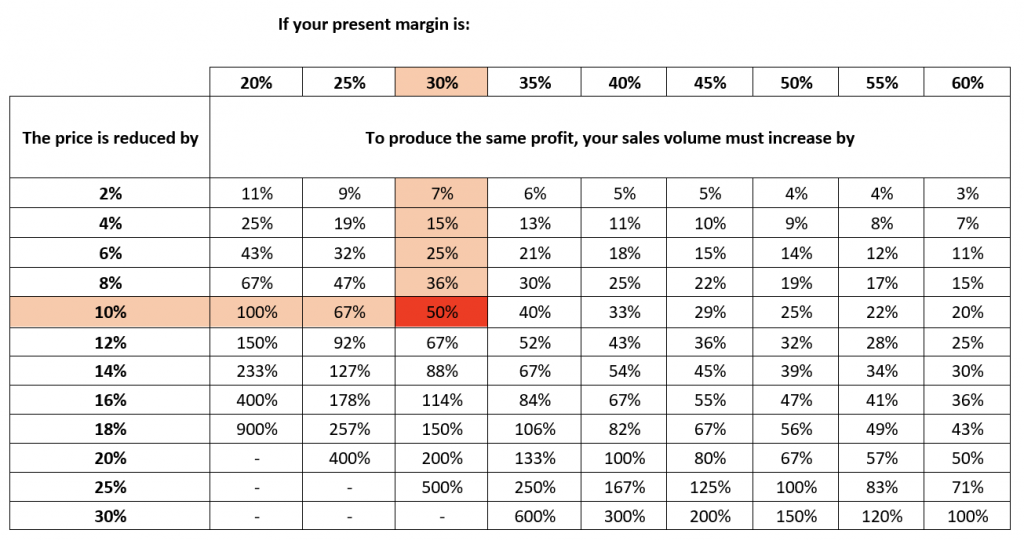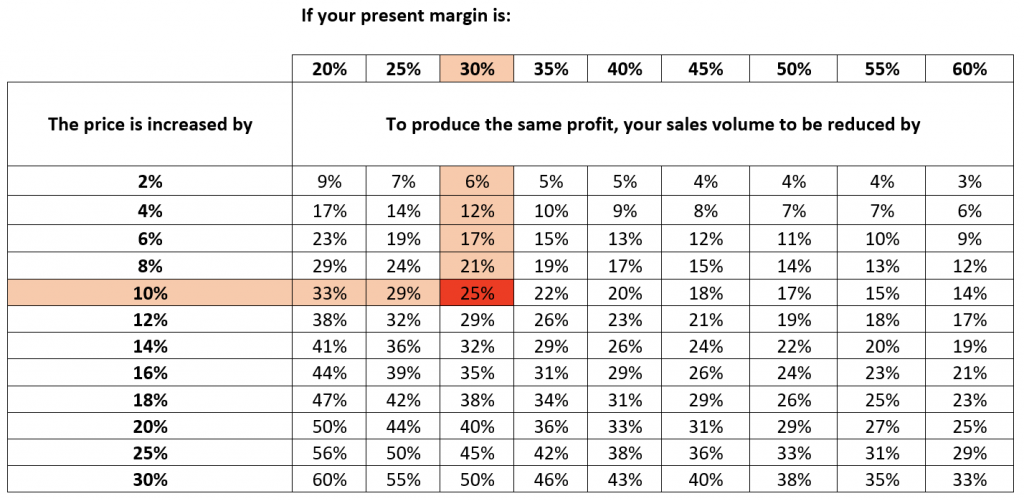
This is the second blog of our ‘Profit Improvement Strategy’ series where we will discuss improving gross profit margin and how to avoid the price trap.
In the first blog, we explain the basic principles to improve business profit from four profit-determining factors including Price, Sales Volume, Variable Costs and Fixed Costs. A profit improvement strategy will involve more than one factor and may result in an increase or decrease in each.
Any successful profit improvement strategy must focus on two things:
- Achieving a higher gross margin per dollar of sales and/or reducing variable costs.
- Achieving greater sales per dollar of fixed costs by increasing the productivity of those with a fixed cost.
In this article, we’ll focus on the first topic – how to strategically achieve a higher gross margin.
So how does this translate to numbers?
Let’s consider a favourable 5% change in each of the four profit-determining factors and look at its impact on your business:

What this shows is that even a small improvement made to each of the four profit-determining factors can combine to have a very large impact and increase your net profit (cash-in-your-pocket). It can be seen that a 5% favourable change in each of the four profit-determining factors would more than double your profit. In this case from $1,000 to $2,190, which is a 119% improvement.
The reverse can also be true. If you neither review the business impacts correctly before taking action nor measure and monitor your results, you may lose profit. For example, suppose you randomly discount your price, allow your sales volume to fall, fail to control your overhead costs or let your variable costs get away from you. In that case, you can destroy a potentially profitable business. This can happen very quickly.
If you get all of the little things right, the big picture looks after itself. But if you get all or some of the little things wrong, you’re going to be in real trouble and probably never know why.
To increase your profit, you must either make a larger gross margin on each dollar of sales or sell more without increasing your fixed costs. If you can achieve both, you will get more cash in your pocket.
Improving your gross profit margin
Your Gross Profit Margin is the difference between the price of your product and what it costs you to buy or make it. Therefore, the only way to increase your gross profit margin is to sell at a higher price or buy/make it at a lower price.
Thoroughly consider the following:
1. Can you buy in or make your product or service for a lower price?
If you rely on Australian distributors or wholesalers to buy in, there may seem limited scope for this. However, be creative and look outside of the square. Our economy is now global. Can you access products of a like quality outside of Australia for a lower price? Can you form or join a network for better or more far-reaching buying power? Franchises have grown principally for this reason.
2. If you have limited scope to buy in at a lower price after careful consideration and research, your selling price is your critical variable.
The most significant single barrier preventing small business managers from making an acceptable profit is their refusal to charge a price that enables them to achieve it. You are not in business to match your competitors’ prices; you are there to service your customers.
However, you do need to get your product mix and your pricing strategy right. Obviously, if you sell the same range of products or services as your competitors, it is easy for customers to compare the price.
Likewise, price discounting to hold or win market share is a lazy strategy. It is only successful where the business has a definite cost advantage (either variable or fixed) over its competitors and the product or service is one where many customers are price-sensitive. In these cases, businesses may use saturation style marketing to convince customers that they are saving money by buying from them. However, the increase in sales volume needed to compensate for a price-discounting strategy is substantial. For example, if your gross profit margin is 30% and you reduce your prices by 10%, you need a sales volume increase by a whopping 50% to maintain your initial profit level. This is illustrated in the following table:

On the other hand, the next table shows that at a 30% margin and a 10% increase in price, you could sustain a 25% reduction in sales volume before your profit falls to the previous level:

If all of your marketing, advertising effort and all of your sales dialogue focus on price, then you will be beaten on price every time a competitor comes along with a lower price. Your customers will judge your products/services and make purchase decisions based on price if that’s the only value you offer.
If you don’t want to compete in this environment, you need to offer something different that customers will be willing to pay a little more. You need a different value proposition or unique product mix from that of your competitors to convince customers to buy from you.
With the right strategy, you also have the opportunity to sell more to your existing customers.
Every business has the potential to command a premium or at least fair and profitable price for its products or services – if – and this is the crunch – it is able to market those products and services in such a way that the customer perceives the added value.
Avoid the price trap
The best way to get out of the price trap is to focus customers on the other benefits that your business offers them. What is in it for them?
Tell them exactly how your product or service will benefit them.
Some features and benefits that you may offer your customers include:
- Better quality
- Comfort, in buying known brands
- Longer warranty periods
- Satisfaction guarantees
- 24-hour accessibility
- More convenient location or better access, parking etc.
- Larger range
- Greater resale value
- Environmental or health advantages
The list goes on.
It’s possible that your competitors may already offer all of these values, but unless you or they emphasise these in their marketing, how will the customer ever know?
A profit-driven marketing strategy is to create the perception of value and back up your sales with excellent service. Price is only important when all other things are equal!
There are some customers who, regardless, think only in terms of price. Invite these to bargain with your competitors! You need to devote your time to working with those people who are happy to pay for value.
This is sometimes easier said than done because the practice goes against a business nature to turn some customer segments away. However, the lesson learned is that price shoppers often take up a lot of your time and have expectations for what they are not willing to pay.
To be profitable in business, you need to get two things right:
1. You must deliver value
2. You must educate your customers to be aware of the value they are getting.
The two go hand in hand, and one without the other leaves your business exposed.
Please feel free to reach out if you need assistance with business strategic planning.
This is general advice only and does not take into account your financial circumstances, needs and objectives. Before making any decision based on this document, you should assess your own circumstances or professional advice from your accountants at KMT Partners.


